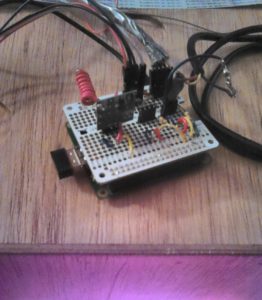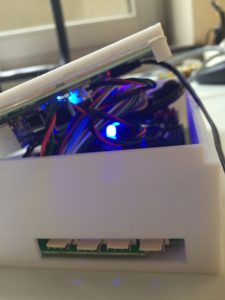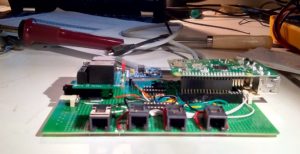
Prototyping Raspberry Pi – What we learned so far !
Since we used the Raspberry Pi for the first few iterations of our prototyping, we thought it would be nice to talk about the background of the device and share what we learned so far, especially for those among you who are not familiar with it.
The Raspberry pi is a series of single board computers developed in the early 2010s’. The first generation of RPis, the legendary model B, was released by the Raspberry Pi Foundation in 2012. The main purpose of this device was to be used as a learning tool that promotes computer sciences, but its success was far better than anticipated and the device ended-up being largely used for prototyping of robotic appliances. By December 2010, 10 million Raspberry Pi units were sold worldwide.
 Our first Rpi Prototype
Our first Rpi Prototype
As opposed to Arduinos based on micro-controllers like the Atmel , the Raspberry pi is a small computer with very diverse capabilities. It can process sound, image, control fans or motors and acquire data from a whole range of different sensors. It is equipped with a powerful processing unit and graphic processor. The most recent version, the Raspberry Pi 3 includes a built in WiFi and Bluetooth chip.
 Arduino
Arduino
We started small, basically connecting a couple of sensors to the Rpi and making it connect to the Internet. We added a couple of additional sensors and actuators like relays and ventilation fans at each iteration on our electronics design. After trying to make it work with various peripherals under many different configurations, we finally came up with a model that perfectly suits our needs.
 Our RPi 3 v1.6 prototype
Our RPi 3 v1.6 prototype
After an exhaustive year of RPI prototyping , we came up with the a couple of reasons to make it your device of choice for personal electronic projects.
- Like the Arduino starter projects, the RPI is a very user friendly device for all everybody who wishes to figure out how computers work and possibly “hack” other electronic devices like ventilation fans, water pumps or even your kitchen micro oven. Numerous Internet community platforms like Instructables or StackOverFlow are already in place to guide you through your projects. Google will become your best friend when it comes to debugging hardware and software issues. Welcome to the world of open-source!
- Most important it is a perfect playground before you decide to take your project to the next level.
What are the major drawbacks of the device?
- It’s costly, especially if you do not need all those GPIOs and computing power.
After having done our bit on prototyping with RPIs, we decided to make it our system of choice for our Alpha units. For our first industrialized batch though, we will go for an industrial micro-controller.
 Alpha version of our IoT chip
Alpha version of our IoT chip
Thanks to the open source community and with Youtube as your tutor, you can make practically any project happen!
Stay tuned, more news coming very soon on our blog and website!
